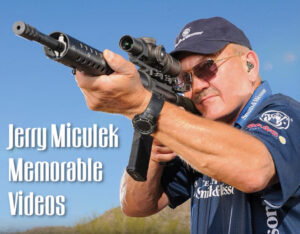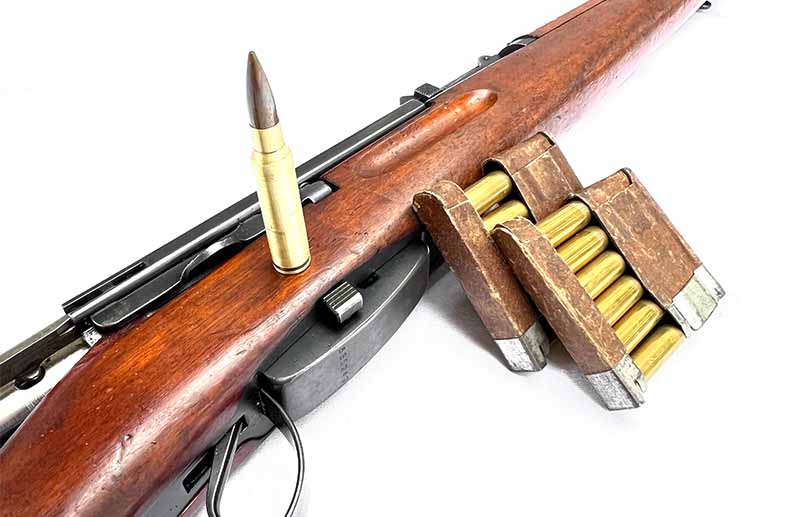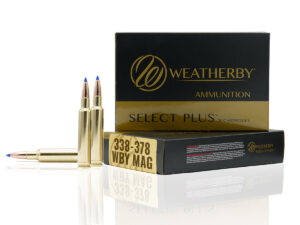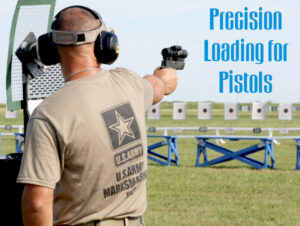Many rifles have been passed down through the ages without being truly tested. Some were too far ahead of the times, while others were a day late and an dollar short. It’s a shame, though, that the Swiss K31 was never used for its intended purpose, an example of notorious Swiss Neutrality. The rifle is so well-made and accurate that it’s become a favorite for vintage military matches in the United States. But even then, the K31 is slowly disappearing from the firing line. The original designs were adopted in 1889 as Switzerland entered into the era of smokeless-powder. The original rifles had massive receivers and strange, elongated magazines. The designers, Eduard Rubin, and Rudolf Schmidt came up with an oversized, complicated action that allowed for a straight-pull operation. The rifle was not very elegant, but it chambered a cartridge that was then quite modern, the 7.5×53.5mm. A newer, more robust version was developed not long after the original. The two designs were confusingly named. The Schmidt-Rubin rifle 1889/96 was a completely new design and parts were not compatible with the original. The bolt was a new design and was much stronger. This design was also ungainly, so mounted troops settled on a straight-pull Mannlicher from abroad chambered for 7.5×53.5mm cartridge. The Mannlicher was not well-liked, so a search for a replacement began. The 1900 short rifle, and the 1905 carbine were also made as stopgaps. However, they were not very good guns and were quickly discarded. The gun was compact but still a bit cumbersome to carry. The ammunition was spitzer bullets, not round-nosed projectiles. The K11 was used for many decades until the trend for shorter, more compact infantry rifles returned. Schmidt and Rubin had died by this time, and never lived to see the final version of their straight-pull-action: the K31. The K31 was similar in size and weight to many 1930s-era military weapons, but it was a last-of-its-kind innovation. The semi-auto, full-power rifle was the next big thing. It was a relic from World War II. Compact guns like the German STG44 would pave the road for the rifles that we know and love today like the AK or AR series. The K31 is a wonder of engineering. Schmidt-Rubin actions may not have been as compact as Mausers or Mosins, but they were more mechanically interesting and better finished. All the years of testing and error culminated in a rifle which was one of the most accurate rifles ever issued to an army. The 7.5x55mm chambering was powerful and, when combined with the K31 gave the individual Swiss soldier or militiaman a dominant advantage in mountainous terrain. The K31 was used by the Swiss Guards at the Vatican and replaced every other rifle in Swiss Service. It was used until the late 1950s, and is still a popular rifle for civilians in Switzerland and America. I’ve searched everywhere and haven’t found any evidence of a K31 ever being used in combat. The political landscape in Europe at the time was not favorable for Switzerland to pick a side, as they had been neutral so long. The Nazis were not fond of them, but they had loose alliances at the time with other neutral countries, such as Sweden. Sweden was notorious for allowing German movement and trade while staying out of the way. The K31 had the “standard” rear sights for Europe at the time. The only adjustment was for elevation. It is unlikely that Swiss border guards fought Nazis, but it is possible they were used to combat other destabilizing elements such as Bolsheviks who tried to enter the country. We’ll probably never know. There isn’t one documented case of the K31 being used in combat. And unless documents from that time period are released (again, doubtful), the K31 remains the best military weapon that never saw action. Straight-Pull ActionStraight pull actions can be a little funny. They have some distinct advantages, but also have some shortcomings. Straight-pull actions were designed because they were faster. The argument could be made that this is true. However, speed is a relative term when it comes to manually operated rifles. The British Enfield is the king of bolt actions. The bolt glides backwards and forwards, and you are on target almost without effort. The Enfield action is relatively weak in comparison to the Mauser. Since the invention of the Mauser, bolt-action rifles have dominated. The Mauser is the strongest type of bolt-action rifle. Almost all of our common rifles, such as the Model 70 or Remington 700, are direct descendants of the Mauser. The complex, precise machining of the bolt facilitates rotation and locking. With training, you can easily work a Mauser Bolt. Unfortunately, Mauser rifles usually came with a fixed 5-round box magazine. It’s a mystery to me why the Germans chose to use this feature for two World Wars, when it would have been easy to extend the magazine or replace the floorplate and trigger guard unit with a removable magazine box, as was common on other German rifles of the time, like the FG42. The K31 action is fast when it works properly. It’s a downside that it takes a lot of physical strength to use it quickly. When the bolt is opened, there’s no camming: You have to rip it straight forward and then run it as hard as possible forward. It’s like a semi auto action without a gas system. The K31 has an excellent trigger, one of the best ever made for a military rifle. If there’s anything that this rifle is good at, it’s accuracy. The two-stage trigger is truly exceptional, not only for a military weapon but for any rifle. The trigger is easy to pull and a pleasure to use. These guns are great because they can shoot match-accurately right out of the box. This is a good option for those who want to start in CMP or other military competitions. I’ve found that the average K31 I’ve shot over the years produces five shots groups of around 2 inches. The gun will hold 4 inches out at 200 yards. The 7.5×55 CartridgeThere are a variety of cartridges that can be used with the K31 family. The GP11 is the cartridge of most interest. This bullet weighs 174 grains and is fired at 2,550 fps. It’s a cartridge that is highly regarded for accuracy, but it’s hard to find today. The surplus market was awash with Swiss-made ammo 15 years ago. It was of high quality and available for a reasonable price. The 7.5x55mm was comparable to other rounds used for similar purposes. From left to right: 7.62 NATO, 6.5x55mm Swedish ammo, 7.62x54R.303 British, 30-06 Springfield, 8x57mm Mauser, and 7.5x55mm Swiss. This cartridge was almost identical to the.308 Winchester/7.62 NATO. Ballistics are almost identical, but each cartridge has a few minor advantages. The 7.62 NATO case is slightly shorter and has a longer overall length. The 7.5 Swiss has a little more capacity. In all practical applications, the 174- and 170-grain weights are virtually identical. There are still a few places that manufacture factory-loaded 7.5 Swiss. The ammunition is becoming harder to find. Only two retailers in the United States had it on hand at the time this article was written. Of course, there are oddball shops that stock this sort of thing. I’ve had good luck in the past at Dunham’s Sports, located in the Midwest. They have oddball calibers on the shelves from time to time. If you can find them, Prvi Partizan FMJ 174-grain (GP11 clone), rounds are around $29 for 20. Brass is also becoming harder to find. The rim diameter of 7.5 Swiss is not the same size as that of.308 Winchester. You can’t also make it from other cartridges. The 7.5 Swiss uses bullets with a.308 diameter, so the selection process is pretty simple. It can also be loaded with most of the powders you would use in.308 Winchester and.30-06 Springfield. My own match load (try it at your own risk!) was a 168 grain Hornady BTHP topped with 41 grains of Hodgdon Varget. Brass was always resized in full length to account for the small chamber dimensions. I loaded them at 2.890 inches OAL using CCI standard large rifle primers and PPU brass. This load was used by my dad and me for many years in CMP competition. This load is the one that I used to win my first CMP gold. The stocks on many K31s are all beaten to hell. This rifle has some dings, but it is not the worst that the author has ever seen. Collecting the K31 TodayThe days of cheap surplus guns are long gone. The price of K31s has doubled and in some cases tripled over the last 10 years. The rifle featured in this article is worth nearly $1,000 today. This puts it in the price range of shooter-grade M1s, but with harder to find ammo and other parts. The rifle shown here is of almost the highest quality. It’s hard to find a K31 in pristine condition under the trigger. The stocks of these guns are often very worn down from being stacked up at camp or exposed to the weather. Even if you don’t agree with Swiss militarism or the use of guns by Swiss soldiers, they did use them. Many people sand and refinish the blemished parts. You can tell by the fact that the stocks are narrower towards the buttplate or comb. I haven’t seen a big difference in the price of these guns after wood restoration. The majority of people don’t care if their stocks have been restored. The receiver is thicker than a Mauser but the rifle as a whole is surprisingly light. There isn’t much difference in price between wood types at this point. Walnut may cost a little more, but it’s not by much. The overall supply of these rifles has begun to shrink. The last few gun shows I attended had only a few — and they were outrageously priced. Ten years ago, the floor was flooded with them. It’s amazing that so few of these guns were ever made. Only half a millon were made. These guns are primarily sought after by people who want to shoot military competition; once they have a good one, they tend to hold onto it. These guns are primarily sought after by people who wish to compete in military competitions; once they find a good one they tend to keep it. Editor’s Note: The article originally appeared in the Gun Digest the magazine May 2023 issue. The target grids and bullseyes are measured in MOA. Subscribe to the Gun Digest newsletter and we will send you your print-at home target pack immediately. Enter your email below.

















